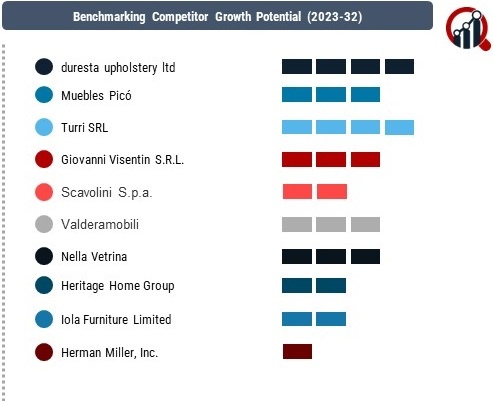Top Industry Leaders in the Luxury Furniture Market

The Glittering Game: Competitive Landscape of the Luxury Furniture Market
The world of luxury furniture is a lavish arena, where craftsmanship dances with affluence, and every piece tells a story of exclusivity. Beyond the gilded veneer, however, lies a fiercely competitive landscape, pulsating with established players, rising stars, and ever-evolving strategies. To navigate this market is to delve into a fascinating tapestry of heritage, innovation, and fierce ambition.
Key Players: Titans of Tradition and Rising Stars -
Duresta Upholstery Ltd (UK)
Muebles Picó (Spain)
Turri SRL (Italy)
Giovanni Visentin S.R.L. (Italy)
Scavolini S.p.a. (Italy)
Valderamobili (S.R.L.) (Italy)
Nella Vetrina (Italy)
Heritage Home Group (US)
Iola Furniture Limited (UK)
Herman Miller, Inc. (US)
Steinhoff International (South Africa)
Strategies Galore: The Quest for Distinction
In this battle for market share, the weapons of choice are varied and multifaceted. Brand storytelling takes center stage, with companies weaving narratives of heritage, exclusivity, and bespoke experiences. Cassina, for instance, champions its collaborations with iconic architects, while Knoll highlights its commitment to sustainable practices.
Digital presences become polished showcases, offering virtual tours of opulent showrooms and personalized consultations with design experts. Social media platforms transform into aspirational portals, where influencers flaunt meticulously curated homes adorned with coveted pieces.
Innovation remains a vital currency. Rove Concepts' modular furniture adapts to ever-changing living spaces, while Poliform's transformable pieces blur the lines between living room and dining area. Sustainability also gains traction, with brands like Restoration Hardware using reclaimed wood and eco-friendly materials.
The Anatomy of Market Share: Beyond the Obvious
Analyzing market share in the luxury furniture market necessitates looking beyond mere sales figures. Brand recognition, perceived value, and customer loyalty play crucial roles. A single statement piece from Hermès can command a king's ransom, even if it accounts for a fraction of overall sales. Similarly, Knoll's enduring legacy and association with iconic architects lend it an invaluable edge.
Furthermore, regional preferences hold sway. The American market leans towards comfort and practicality, while European tastes skew towards classicism and artisanal flair. Asian luxury consumers, meanwhile, seek statement pieces that exude exclusivity and grandeur. Understanding these nuances is crucial for brands seeking to expand their global footprint.
New Frontiers: Embracing Change in a Shifting Landscape
The future of the luxury furniture market promises to be as dynamic as its present. Technology is a game-changer, with augmented reality allowing customers to virtually "try on" furniture in their homes, while 3D printing opens doors to bespoke customization. Online marketplaces like 1stDibs and Chairish offer curated collections and vintage finds, catering to a growing segment of eco-conscious and budget-conscious luxury consumers.
Sustainability practices are no longer a fad, but a necessity. Brands are exploring eco-friendly materials, responsible sourcing, and upcycling initiatives to cater to a consumer base increasingly concerned about the environmental impact of their purchases.
Collaboration is another key trend, with luxury furniture brands teaming up with fashion houses, artists, and even tech giants to create unique and buzzworthy pieces. This cross-pollination of ideas injects fresh energy into the market and expands brand reach to new audiences.
Investment Waves: Where the Money Flows
In this high-stakes game, venture capitalists are taking notice. Startups focusing on innovative materials, sustainable practices, and online platforms are attracting significant investments. Companies like Interior Define and Furnished offer custom-made furniture at accessible price points, appealing to a younger generation of luxury consumers.
Meanwhile, established brands are also attracting investment, primarily for expansion into new markets and digital capabilities. The online luxury furniture market is projected to boom in the coming years, and brands are scrambling to secure their positions in this lucrative space.
The Current Scenario: A Thriving Arena with Unpredictable Twists
The luxury furniture market is currently a vibrant tapestry, woven with tradition, innovation, and fierce competition. New players are challenging established names, while technology and sustainability are reshaping the game. With consumer preferences evolving and investment dollars flowing, the future promises to be exciting and unpredictable.
Recent Development :
In October of 2022, Linly Designs made a move to acquire Marge Carson, a prestigious name in crafting high-end residential furniture. This acquisition aims to boost both operational effectiveness and the range of products available.
In December 2022, assumed control of Brosa, a major player in Australia's online luxury furniture retail scene. This strategic takeover is poised to breathe new life into the brand, leveraging the backing of the Kogan Group to revitalize its operations.










